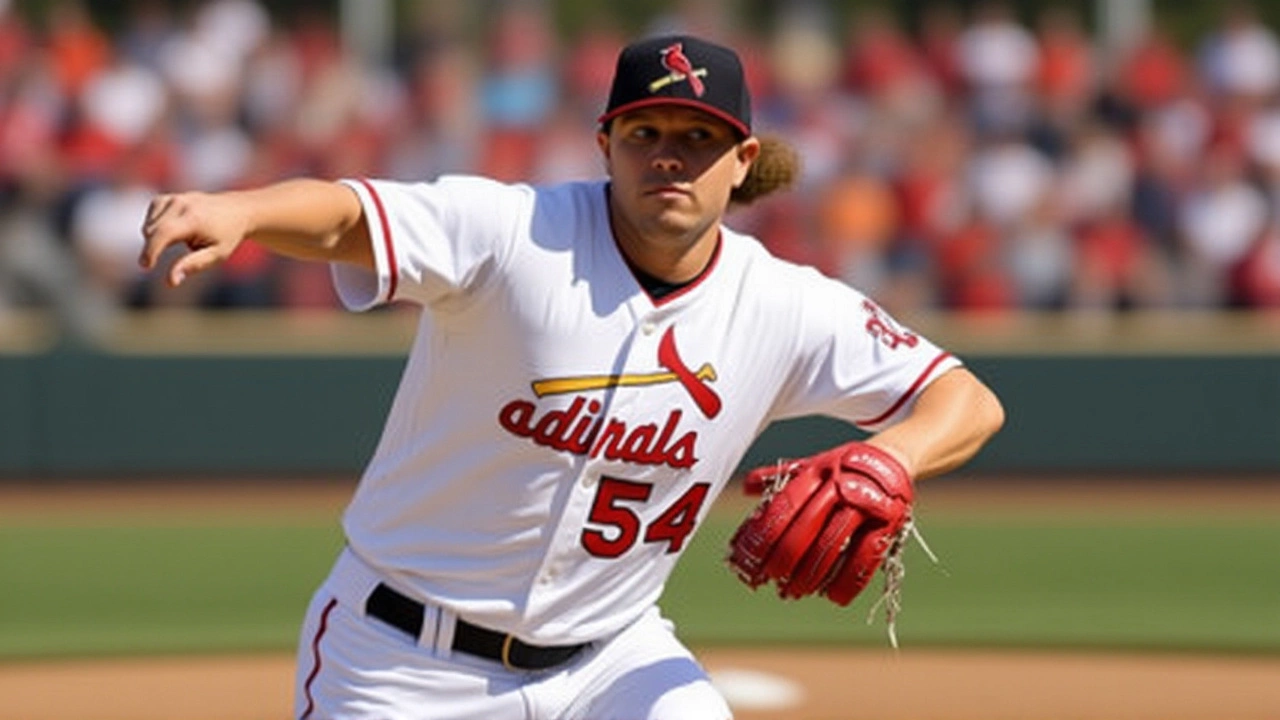Red Sox Land Sonny Gray in $20M Cash Trade as Cardinals Shift to Rebuild

The Boston Red Sox made a bold move to bolster their rotation for the 2026 season, acquiring veteran right-hander Sonny Gray from the St. Louis Cardinals on November 25, 2025—a deal that included a staggering $20 million cash payment from St. Louis to offset Gray’s massive salary. The move, finalized just before the MLB winter meetings, signals Boston’s intent to push for a deep playoff run after missing the postseason in 2025. Gray, 36, waived his no-trade clause to join the Red Sox, and while the Cardinals shed a looming financial burden, they received two pitching prospects in return: left-hander Brandon Clarke and right-hander Richard Fitts. The trade, orchestrated by Craig Breslow, Boston’s Chief Baseball Officer, and Chaim Bloom, the Cardinals’ new president of baseball operations, is a rare example of a team paying another to take a contract off its hands.
Why the Red Sox Took the Risk
Gray’s 2025 season was a tale of two stats. He posted a 14-8 record with a 4.28 ERA over 180⅔ innings, but his Fielding Independent Pitching (FIP) of 3.39 suggested he was robbed by bad luck—his peripherals told a better story. Over 14 MLB seasons, Gray has been one of the most consistent workhorses in the game: 125 wins, 1,925 strikeouts, and a career 3.58 ERA. He’s not the flamethrower he was in his 20s, but he’s a cerebral pitcher who commands four pitches with precision. For the Red Sox, who finished 85-77 in 2025, Gray becomes the clear No. 2 starter behind ace Garrett Crochet. That’s a critical upgrade. Boston’s rotation was a liability last year; Gray’s presence alone makes them a more formidable playoff contender.
Here’s the twist: the $20 million cash from St. Louis doesn’t just make Gray affordable—it makes him tax-friendly. The Red Sox were projected to hit the Competitive Balance Tax (CBT) threshold for the first time since 2022. Gray’s original $35 million salary for 2026 would have pushed them well over. But with the Cardinals covering $20 million, Boston’s luxury tax hit drops to $15 million. That’s a massive win. According to MLB.com, this maneuver leaves Boston with roughly $20 million of breathing room before hitting the next tax tier. And if Gray reworks his deal—as reported by CBS Sports—to a $31 million 2026 salary with a $10 million guaranteed buyout on the 2027 mutual option, he’ll actually earn more overall, just spread out. The Cardinals win by shedding payroll; the Red Sox win by gaining a proven arm without breaking the bank.
The Prospects the Cardinals Got
For the Cardinals, this trade is a rebuild in motion. They didn’t get a top-100 prospect, but they did get two arms with upside. Brandon Clarke, 22, is a 6-foot-4 lefty drafted in the fifth round in 2024. In his first pro season, he made 14 starts between Single-A and High-A, striking out 60 batters in just 38 innings. His control is still raw—he walked 21—but his stuff is electric. He’s the kind of pitcher who could develop into a mid-rotation starter if he stays healthy. Richard Fitts, 25, has more MLB experience but less durability. He made 14 starts over two seasons with a 3.97 ERA, but his 2025 campaign ended prematurely in August due to right arm neuritis. He also missed time in April with a pectoral strain. The Cardinals are betting on his arm strength and the idea that a change of scenery might help him regain consistency.
What’s notable? The Red Sox held onto their top two pitching prospects, Payton Tolle and Kyson Witherspoon. That means St. Louis didn’t get a future ace—they got depth. And they gave up $20 million to do it. That’s a financial gamble, but one that aligns with Bloom’s philosophy: clear the books, invest in youth, and let the farm system carry the future.
Behind the Scenes: The Negotiation
The trade wasn’t just about numbers—it was personal. Bloom, who spent nearly a decade running the Red Sox front office before joining St. Louis in 2025, knows Boston’s system inside out. He was the architect of their 2018 World Series run. Now, he’s dismantling parts of it. Meanwhile, Breslow, who replaced Bloom in Boston, had been quietly building toward this moment. He didn’t want to overpay for a rental. He wanted a veteran who could anchor the rotation for a full season. Gray fit perfectly. Sources say Gray was initially hesitant to waive his no-trade clause, but after conversations with Breslow and a promise of a clear role, he agreed. “He’s the kind of guy you want in the clubhouse,” one insider told NESN. “He’s got a quiet leadership, knows how to pitch under pressure.”
Adding to the intrigue: the deal included a player to be named later—or additional cash. That’s a common tactic when teams want to keep flexibility. The Cardinals might get a low-level prospect or another small cash payment later, but the core of the trade is set.
What This Means for 2026
The Red Sox aren’t done. With Gray in the fold, they now have a stable top three: Crochet, Gray, and likely Nick Pivetta or Brayan Bello. They’re also expected to add a left-handed bat and a bullpen arm before Opening Day. The goal? Win the AL East and make a serious October push. Gray’s experience in high-leverage games—his 2019 postseason run with Minnesota was electric—could be the missing piece.
For the Cardinals, the path is murkier. They’re in transition. They traded a proven starter for two unproven arms and $20 million in cash. That’s not a sign of strength—it’s a sign of surrender. But in today’s MLB, where small-market teams can’t compete on payroll, rebuilding through prospects and financial flexibility is the only way forward. The Cardinals aren’t trying to win in 2026. They’re trying to survive it.
What’s Next?
Gray will report to Red Sox spring training in Fort Myers in February. He’ll likely wear No. 47, his long-time number. The Cardinals will begin evaluating Clarke and Fitts in extended spring training, with Clarke expected to start 2026 in High-A. Meanwhile, both front offices will keep an eye on the trade market—especially for bullpen arms. With Gray’s contract now restructured, Boston may have room to make another move. And St. Louis? They’ll be watching how their young pitchers develop—and hoping the $20 million they paid doesn’t come back to haunt them.
Frequently Asked Questions
How does this trade affect the Red Sox’s chances in the AL East?
Adding Sonny Gray gives Boston a reliable, experienced No. 2 starter behind Garrett Crochet, turning a shaky rotation into a legitimate strength. With Gray’s 2025 ERA of 4.28 and FIP of 3.39, he’s due for better luck—and he’s proven he can perform in pressure situations. Combined with Boston’s improved bullpen and expected offensive upgrades, they’re now serious contenders to overtake the Yankees and Orioles in the division.
Why did the Cardinals send $20 million to Boston?
The Cardinals were stuck with a $35 million salary for 2026 and a $30 million mutual option for 2027. With Chaim Bloom prioritizing financial flexibility and youth development, they chose to pay Boston to take the contract. This avoids a potential $5 million buyout if Gray declines the option and allows them to free up payroll for younger pitchers like Clarke and Fitts without being locked into long-term commitments.
Is Sonny Gray still effective at 36?
Yes, but differently. Gray doesn’t throw 98 mph anymore—he relies on command, movement, and sequencing. His 2025 strikeout-to-walk ratio of 5.3:1 was elite, and his 1.23 WHIP ranked in the top 15 among qualified starters. He’s not a frontline ace anymore, but as a No. 2 starter in a playoff rotation, he’s one of the best available. Teams pay premium prices for pitchers with his consistency and durability.
What does this mean for the Red Sox’s luxury tax situation?
The $20 million payment from St. Louis cuts Gray’s luxury tax hit in half. Instead of counting $35 million against the tax, Boston only counts $15 million. This keeps them just below the $330 million CBT threshold, avoiding a $3 million tax penalty. It’s a brilliant financial maneuver—Boston gets a top-tier starter without paying the full cost, and they retain flexibility to add bullpen help later.
Why didn’t the Cardinals get a top prospect in return?
The Red Sox protected their top two pitching prospects, Payton Tolle and Kyson Witherspoon, in the deal. Brandon Clarke was their No. 5 prospect, and Richard Fitts was a depth arm with injury concerns. St. Louis prioritized payroll relief over immediate talent, which reflects their long-term rebuild strategy. They’re betting that Clarke’s raw tools can be developed, even if he’s not a top-100 name right now.
Could Sonny Gray be traded again before 2027?
It’s possible. Gray’s restructured deal includes a $10 million guaranteed buyout if the mutual option is declined. If he pitches well in 2026 and Boston is in contention, they might extend him. But if they’re out of it, and his value rises, they could flip him at the 2026 trade deadline for a higher return. His contract now has more flexibility, making him a more attractive trade chip than before.

